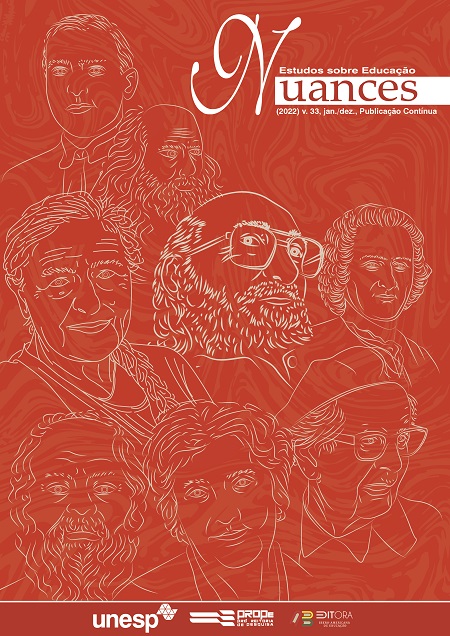Application of geography teaching methodologies aimed at blind students
A social inclusion proposal
DOI:
https://doi.org/10.32930/nuances.v33i00.9491Keywords:
Geography, Blind, Inclusive educationAbstract
One of the great challenges for inclusive education is teacher training and practice, which often does not meet the demand and need for this type of teaching. An inclusive school must be understood in a broad sense and not just as an individual case, as it is a reality to be discussed. Therefore, the teacher must work with the entire school community; after all, inclusive education counts on the active participation of all so that this practice is effective. Therefore, this work aims to contribute to studies in the area, seeking to reduce the existing gap and help in the identification of teaching methodologies of Geography that improve the understanding of the blind. This article has an integrative research character, allowing a broad methodological approach based on experimental and non-experimental research to complete the understanding of the researched phenomenon. This research was carried out through articles published between 2016 and 2022, focusing on articles found in several databases, such as Google Scholar. From the review carried out where the results obtained by other authors were analyzed, it can be concluded that an inclusive education, in which everyone can enjoy knowledge is what we try to discuss through this present work. Exposing the immense challenge that involves the school-student-teacher tripod; It was presented as a result of this research questions that have in view the problem of inclusive education for blind and low vision students, because it was starting from a real situation of the school daily life that we opened the range of this very important variety of teaching, school inclusion.
Downloads
References
ALVES, D. A. A cartografia tátil: Um recurso didático para ensinar geografia a deficientes visuais. In: ENCONTRO NACIONAL DE PRÁTICA DE ENSINO DE GEOGRAFIA: POLÍTICAS, LINGUAGENS E TRAJETÓRIAS, 14., 2019, Campinas. Anais [...]. Unicamp, 2019. Disponível em: https://ocs.ige.unicamp.br/ojs/anais14enpeg/article/view/2964. Acesso em: 01 abr. 2021.
AGUIAR, P. R.; COSTA, F. W. D. O ensino de geografia na perspectiva da educação inclusiva no Instituto Federal do Triângulo Mineiro–campus Patrocínio-MG. Estudos Geográficos: Revista Eletrônica de Geografia, v. 19, n. 3, p. 26-47, 2021. Disponível em: https://www.periodicos.rc.biblioteca.unesp.br/index.php/estgeo/article/view/16100. Acesso em: 01 abr. 2021.
BESERRA, J. D. V. C. Maquete tátil com legenda braille: Educação inclusiva no ensino de geografia. 2017. Trabalho de Conclusão de Curso (Licenciatura em Geografia) – Centro de Formação de Professores, Universidade Federal de Campina Grande, Cajazeiras, Paraíba, Brasil, 2017. Disponível em: http://dspace.sti.ufcg.edu.br:8080/jspui/handle/riufcg/6112. Acesso em: 09 abr. 2021.
BRASIL. Lei n. 9.394, de 20 de dezembro de 1996. Estabelece as diretrizes e bases da educação nacional. Brasília, DF: Presidência da República, 1996. Disponível em: https://www.planalto.gov.br/ccivil_03/leis/l9394.htm. Acesso em: 14 mar. 2021.
COOK, J. P. et al. Cartografia tátil no ensino de geografia física na educação básica. PESQUISAR–Revista de Estudos e Pesquisas em Ensino de Geografia, v. 7, n. 14, p. 15-28, 2021. Disponível em: https://periodicos.ufsc.br/index.php/pesquisar/article/view/74398. Acesso em: 08 ago. 2021.
FERREIRA, P. S.; SILVA, A. C.; SILVA, A. M. G. Práticas escolares em geografia para inclusão do aluno com deficiência visual. Educação geográfica em movimento: Saberes, práticas e perspectivas, 2021.
GENUINO, V. S. A cartografia tátil como prática educacional no ensino inclusivo da geografia. 2018. Trabalho de Conclusão de Curso (Graduação em Geografia) – Universidade Federal da Paraíba, João Pessoa, 2018. Disponível em: https://repositorio.ufpb.br/jspui/handle/123456789/14028. Acesso em: 29 jul. 2021.
HAMUD, J. A. Ensino de climatologia no 6º ano com apoio de recursos didáticos táteis: Possibilidades para uma geografia escolar inclusiva. 2021. Trabalho de Conclusão de Curso (Graduação em Geografia) – Universidade Federal de Santa Catarina, Florianópolis, 2021. Disponível em: https://repositorio.ufsc.br/handle/123456789/223636. Acesso em: 09 jun. 2021.
JUNIOR, R. L. F.; COSTA, V. C. Geotecnologias Como Subsídio a Práticas de Ensino em Geografia Para Alunos de Baixa Visão do Ensino Fundamental do Instituto Benjamin Constant (IBC). Geografia Ensino & Pesquisa, v. 21, n. 2, p. 135-145, 2017. Disponível em: https://periodicos.ufsm.br/geografia/article/view/25952. Acesso em: 06 ago. 2021.
MEDEIROS, M. I. Educação Inclusiva e o Ensino de Geografia: Uma perspectiva por meio da Cartografia Tátil. 2019. Trabalho de Conclusão de Curso (Graduação em Pedagogia) – Universidade Federal de Mato Grosso, Instituto de Ciências Humanas e Sociais, Rondonópolis, 2019. Disponível em: https://bdm.ufmt.br/handle/1/1233. Acesso em: 14 mar. 2021.
RODRIGUES, T. T.; SALDANHA, C. S.; CORRÊA, L. R. A cartografia inclusiva e o futuro no ensino da geografia. In: CONGRESSO INTERNACIONAL DE EDUCAÇÃO, 7., 2017, Santa Maria. Anais [...]. Santa Maria, 2017. Disponível em: https://revistas-old.fapas.edu.br/index.php/anaiscongressoie/article/view/943/807. Acesso em: 15 fev. 2021.
SILVA, R. A. Recursos didáticos táteis: Intervenções educacionais para mediar o ensino da Geografia para estudantes cegos. 2019. Dissertação (Pós-Graduação em Gestão de Ensino da Educação Básica) – Universidade Federal do Maranhão, São Luís, 2019. Disponível em: https://tedebc.ufma.br/jspui/handle/tede/2869. Acesso em: 22 maio 2021.
SOUZA, L. P. O ensino da Geografia acessível a pessoas com deficiência visual por meio do uso de globos terrestres táteis. 2020. Trabalho de Conclusão de Curso (Graduação em Geografia) – Universidade Federal de Santa Catarina, Florianópolis, 2020. Disponível em: https://repositorio.ufsc.br/handle/123456789/220173. Acesso em: 18 maio 2021.
Published
How to Cite
Issue
Section
License
Copyright (c) 2022 Nuances: estudos sobre Educação

This work is licensed under a Creative Commons Attribution-NonCommercial 4.0 International License.
Atribuição-NãoComercial
CC BY-NC
Esta licença permite que outros remixem, adaptem e criem a partir do seu trabalho para fins não comerciais, e embora os novos trabalhos tenham de lhe atribuir o devido crédito e não possam ser usados para fins comerciais, os usuários não têm de licenciar esses trabalhos derivados sob os mesmos termos.





